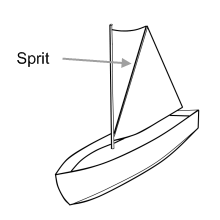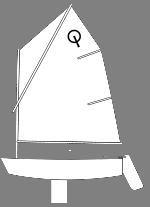


On the left the photo of the sail (100).
You have to go through the sewing workshop, the mast is simple to make. If you are a handyman, no problem.
The sail is mounted with a rudder of course that I suggest you make if your kayak does not have one. Sailing downwind, crosswind, upwind. If you know how to sail it's no problem. You can paddle with the sail unfolded whatever the wind direction, even headwind, and of course with the sail folded up.
The set does not require any drilling on the kayak unless you decide to fix the foot of the mast directly on the kayak without the wooden support (visible cross on the photo) and you do not have a life line.
"Characteristics.
Allows you to go upwind.
Allows you to paddle with the sail unfolded or folded.
Unfolded and folded in 2 seconds.
Allow you fishing.
Light and resistant.

This type of kayak sail is very old, there are representations of it as early as the 2nd century BC among the Greeks.
A spar or lovard sail allows to stretch the gaff sail from the bottom of the mast upwards. Used by the river navy, it was adapted to the folding or removable masts of various boats, such as barges, barges and certain barges.
This type of sail has been used by optimists since 1947.
Its effectiveness depends on the aerodynamic finesse of the boat, in the case of the kayak some are more tapered but less stable and others less tapered but more stable. In both cases the performance is good.
The lighter the wind, the bigger the sail can be, the stronger the wind, the smaller the sail can be, hence the interest in making several sails, adapted to the weather conditions, to the boat, to your level.
For the assembly that I propose to you the change of sail is done simply by a pin.
